A hunting knife
by Don Caswell
Hunter 5
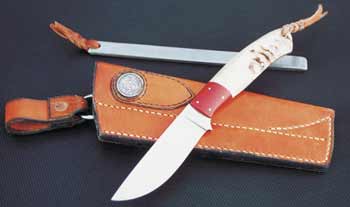 For hunters of any region and era, the most essential tool in their kit is a knife. Australia hosts some of the world’s best master knife makers and a custom-made hunting blade is not out of reach of the ordinary man or woman. The following details the concept, making and use of an Australian hunting knife.
For hunters of any region and era, the most essential tool in their kit is a knife. Australia hosts some of the world’s best master knife makers and a custom-made hunting blade is not out of reach of the ordinary man or woman. The following details the concept, making and use of an Australian hunting knife.
Once you have gained a little experience you can appreciate the often subtle differences between a quality item and a run-of-the-mill specimen. This applies to cars, boats, rifles, optics or, in fact, any item that we may use. It certainly applies to knives.
From my earliest memories I held an interest in knives. This was not surprising given that my father earned his living with a knife as a boner in the meatworks. Most afternoons he would spend a little time under our house sharpening his knives, sometimes also working the wooden handles into a more comfortable shape for his hands. Like all small children I was keen to emulate my dad and it was not long before I was standing beside him doing my best to put an edge on an old kitchen knife. As a result, I learnt to sharpen knives at a very young age.
At our house it was unwise to rummage carelessly in the kitchen cutlery drawers. Between Dad and myself, everything except the bread and butter knives held an edge you could shave with. The old bloke always said that a sharp knife was a safe knife, in that no great force was needed to use it. Most accidents happen when people exert a lot of force in trying to make a dull blade cut.
I’ve been a lifelong devotee of camping, hunting and fishing and have been fortunate enough to live in remote places where a good bag was generally guaranteed. During the years I have used lots of different knives and slowly developed an appreciation for what worked best for me in different applications. I am also a minimalist and like to travel light. The quest for a general-purpose knife has been a long one.
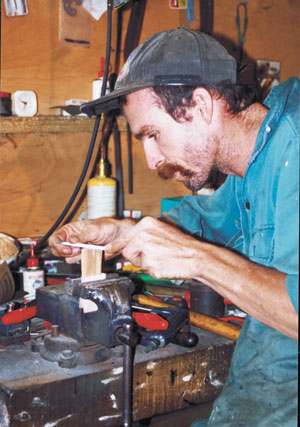 For many years I used butcher’s knives for hunting and fishing. My main interest was in a knife with quality steel that would take and hold a good working edge. As I developed an appreciation of the advantages that the shape of the knife conferred, I started to buy factory-made hunting and fishing knives. In this I was initially disappointed, having restricted myself to the budget end of the market. As I said, I have always had an interest in knives, but not a fascination, and I found it difficult to justify the dollars required to acquire top-end factory knives.
For many years I used butcher’s knives for hunting and fishing. My main interest was in a knife with quality steel that would take and hold a good working edge. As I developed an appreciation of the advantages that the shape of the knife conferred, I started to buy factory-made hunting and fishing knives. In this I was initially disappointed, having restricted myself to the budget end of the market. As I said, I have always had an interest in knives, but not a fascination, and I found it difficult to justify the dollars required to acquire top-end factory knives.
Once again I was fortunate to have friends who were more deeply immersed into knife lore than I and who had treated themselves to quality blades. They were quite happy for me to use their blades in the field and I began to appreciate the benefits of a well-designed and constructed hunting knife. The next quantum leap for me was the advent of the custom-made knife. Having gained a little experience in knife use and developed opinions about what qualities a knife should have, it was easy to appreciate the subtle benefits of custom-made knives.
Top-end factory knives and custom-made knives represent a substantial investment and it took me three or four years of deliberation before I committed to my first custom blade. This was a folder commissioned from Peter Bald to replace my worn-out pocketknife. It remains my most used knife for general-purpose application. Nowadays, with new state laws further enhanced by the events of September 11, I can unfortunately no longer carry a pocketknife everywhere with me, as was my wont for several decades.
In recent years my hunting has picked up a little and I was in a position to justify a custom hunting knife. This was helped along by having a couple of teenage boys who were also competing for the available knives in our hunting kit. I had a pretty clear picture of the style of knife I wanted and started to do a little homework. Things were not exactly progressing rapidly until the occurrence of the Brisbane knife show in February 2002.
I had never previously had an opportunity to attend a knife show and it was quite an experience. Apart from the opportunity to finally meet Peter Bald and other personalties from the knife-making scene, it was fabulous to see the display of knives from both established and tyro knife makers. I would encourage anyone with even the mildest interest in knives to attend a show when the opportunity arises.
Australia’s top knife makers find a ready market in the USA, where a number of them are well known and respected. The web site www.unitedbladeworx.com.au features the profiles and portfolios of a number of Australia’s better-known knife makers, as well as the Australian Knifemakers Guild. It is a web site well worth a visit and browse.
Despite commanding retail prices equal to thousands of Australian dollars per knife in the US market, our leading Aussie knife makers still produce custom blades for the home market at a price that is on a par with top-end factory blades.
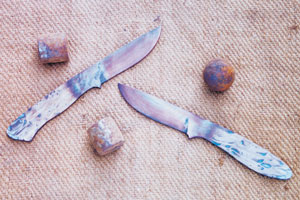 As I walked around the knife displays I was looking for a hunter with a blade of about 120mm, reasonable point drop, a generous amount of handle and good balance. The knife’s use would be in the field dressing and breaking up of deer, ’roo and goat carcasses. I wanted a knife that would take and hold a good working edge. The sheath needed to be of the deep holster type and include a small sharpening steel. It is a style that seems to be popular with Kiwi deer hunters and is very practical for foot hunters who need to carry all the essentials with them.
As I walked around the knife displays I was looking for a hunter with a blade of about 120mm, reasonable point drop, a generous amount of handle and good balance. The knife’s use would be in the field dressing and breaking up of deer, ’roo and goat carcasses. I wanted a knife that would take and hold a good working edge. The sheath needed to be of the deep holster type and include a small sharpening steel. It is a style that seems to be popular with Kiwi deer hunters and is very practical for foot hunters who need to carry all the essentials with them.
If you had to dress an animal with a piece of broken glass or at the other extreme, say a sword, you could certainly do so. It would be slow and inconvenient, but with perseverance you could accomplish the job. A butcher’s knife or a bowie would be much more convenient and easier to use. Better again is the classic drop point hunting knife with 100 to 150mm of blade. This is especially so if, as often seems to be the case, you are trying to do the job in an awkward spot as darkness sets in. If you are a regular hunter who takes more than one or two animals per year then you would have even more need for an appropriate knife.
After a lap or two of the venue I had found two knife makers who offered exactly what I was looking for in a hunting knife. I chatted to both and inspected their wares closely and was impressed with the quality of workmanship. My goal was a practical working knife at a reasonable price, not a collector’s piece.
I was particularly taken with Steve Filicietti’s forged hunters. I liked the style, feel and balance of these blades, along with the quality leatherwork that accompanied them and Steve’s assurance as to their edge-holding capabilities. When I learned that Steve lived only a few kilometres from me I postponed an immediate decision and arranged to visit him at his workshop.
As opportunity allowed, I made a series of visits and talked with Steve while he worked. Steve forges all his blades by hand and each is unique in its own way. While my interest was largely focused on my hunting knife, I was nevertheless intrigued by a selection of Steve’s big bowie knives destined for export to the southern states of the USA. These awesome knives seemed surprisingly light and beautifully balanced, almost floating in your hand, a testimony to their maker’s skill and the intricate mosaic of the Damascus patterned steel was a delight to the eye. However, appealing as these beautifully crafted knives were, I had neither the use nor the funds to acquire one.
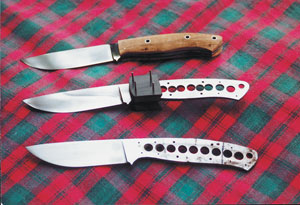 The fact that Steve forged a lot of his hunters from ball bearing steel also had me curious. I was under the impression that this is normally a difficult, even impossible, thing to do. Steve confirmed that it was uncommon, saying that only a few knife makers in Australia actually forged such steel into blades. Ball bearing steel, 52100 series high carbon steel to be specific, tends to crumble and shatter during forging unless exactly the right temperature is achieved. The optimum forging temperature is in the orange heat range.
The fact that Steve forged a lot of his hunters from ball bearing steel also had me curious. I was under the impression that this is normally a difficult, even impossible, thing to do. Steve confirmed that it was uncommon, saying that only a few knife makers in Australia actually forged such steel into blades. Ball bearing steel, 52100 series high carbon steel to be specific, tends to crumble and shatter during forging unless exactly the right temperature is achieved. The optimum forging temperature is in the orange heat range.
Steve’s workshop also surprised me with its simplicity. I had expected to see something like a gunsmith’s workshop, with fancy milling machines and other high-tech metal working tools. But his workshop featured merely a small drill press and a bench belt sander in the way of power tools. There were a couple of vices and a selection of files and that was about it. Steve forges his blades to a shape that is close to that required of the finished knife and stock removal is minimal. He does most of the finishing work by hand with his files.
Fortunately, I was able to view most steps in the process of making a batch of hunters. Right from the start I had my eye on one piece that seemed to have the size and shape I was looking for. It was fascinating to see the rough blank progress to a slick finished product. There was a range of options available for the handgrips and I opted for sheep horn.
Steve, who is a qualified saddler, produced a delightful leather sheath that incorporated the short sharpening steel. Another innovation was a swivel so that the sheath can pivot from the belt attachment. This is very useful and allows easy mounting, dismounting and riding in vehicles, particularly for longer knives.
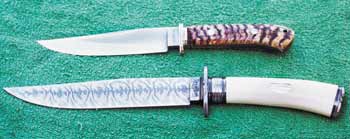 I also had Steve set a one-shilling piece into the sheath. This old coin, minted in the year I was born, features a merino ram in bold relief. It is an appropriate memento for several reasons. The shilling, being from my birth year, reminds me of my old mum who only recently passed away. My dad boned a legion or two of sheep in his time and that coin, plus the sheep horn grips, was a little homage to the old fellow and his lifetime of honest toil. The horn grips and merino ram also evoked fond memories of my time spent hunting out west on my buddy’s sheep property.
I also had Steve set a one-shilling piece into the sheath. This old coin, minted in the year I was born, features a merino ram in bold relief. It is an appropriate memento for several reasons. The shilling, being from my birth year, reminds me of my old mum who only recently passed away. My dad boned a legion or two of sheep in his time and that coin, plus the sheep horn grips, was a little homage to the old fellow and his lifetime of honest toil. The horn grips and merino ram also evoked fond memories of my time spent hunting out west on my buddy’s sheep property.
All up, the cost of the completed knife was $350 including GST. An unembellished hunter with sheath would cost, in mid 2002, about $300, which certainly puts it on a par with top-end factory knives and the products of other home-grown knife makers. A bonus was seeing its fiery birth and progress from old ball bearings to a unique, quality finished piece, with exactly the balance, utility and style I was seeking. It was also a treat to see an unassuming Aussie artisan, with a strong bush connection, quietly demonstrate skills and knowledge patiently acquired throughout years of application to his calling.
Naturally, I was itching to try out my new knife and did not have to wait long. A few days after Steve handed me the finished knife the boys and I were off on our annual two-week hunt. We had permits and tags for ’roos and were intending to bring home some prime meat and maybe a couple of good red skins. There were goats and pigs to be had by stalking the gidgee and we would get our share of these as well.
The knife functioned flawlessly. The balance and style of the blade made field butchering just that much easier. The forged bearing steel held a good working edge that required minimum effort to maintain. The boys were keen to use it and did more than their share of the butchering, which was a relief for my creaking old back. In the immediate future the knife will be used on red deer, and next year buffalo and wild cattle will be on the menu too. I’m looking forward to many a year’s service from it.
